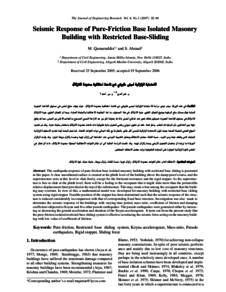Document
Seismic response of pure-friction base isolated masonry building with restricted base-sliding.
Contributors
Ahmad, S., Author
Publisher
Sultan Qaboos University
Gregorian
2007
Language
English
Subject
English abstract
The earthquake response of pure-friction base isolated masonry building with restricted base sliding is presented in this paper. A clear smoothened surface is created at the plinth level of the building above the damp-proof course, and the superstructure rests at this level to slide freely, except for the frictional resistance and the rigid stopper. As the superstructure is free to slide at the plinth level, there will be a feeling to the occupants that it might slide more than the permissible relative displacement limit provided at the top of the substructure. This may create a fear among the occupants that the building may overturn. In view of this, a mathematical model was developed for masonry building with restricted base sliding system using rigid stopper. Feasible position of the stopper has been determined such that the seismic response of the structure is reduced considerably in comparison with that of corresponding fixed base structure. Investigation was also made to determine the seismic response of the buildings with varying time period, mass ratio, coefficient of friction and damping coefficient subjected to Koyna and five other pseudo earthquakes. The pseudo earthquakes were generated either by increasing or decreasing the ground acceleration and duration of the Koyna accelerogram. It turns out from the present study that the pure-friction isolated restricted base sliding system is effective in reducing the seismic force acting on the masonry building with low value of coefficient of friction.
Member of
ISSN
1726-6742
Resource URL
Citation
Qamaruddin, M., & Ahmad, S. (2007). Seismic response of pure-friction base isolated masonry building with restricted base-sliding. The Journal of Engineering Research, 4 (1), 82-94.
Arabic abstract
في هذه الورقة سيتم عرض دراسة للاستجابة الزلزالية لمبنى طابوقي ذي قاعدة احتكاكية محدودة الانزلاق. حيث يتولد سطح أملس في مستوى القاعدة الحجرية للبناية فوق مدمال مانع الرطوبة، ويتيح للهيكل العلوي حرية الانزلاق في هذا المستوى، ما عدا المقاومة الاحتكاكية والمثبتة الصلبة. وبما أن الهيكل العلوي حرية الانزلاق للانزلاق في مستوى القاعدة الحجرية، فسيكون هناك شعور عند شاغلي المبنى بأنه قد يتحرك أكثر من حد الازاحة النسبي المسموح به للجانب الأعلى من المبنى، مما قد يخلق خوفا بين الشاغلين بأن البناية قد تنقلب. ونظر لهذا، فقد تم تطوير نموذج رياضي لتمثيل بناية طابوقية ذات قاعدة محدودة الانزلاق باستخدام مثبتة صلبة. وقد تم تحديد الموقع العملي للمثبتة الصلبة بحيث تكون الاستجابة الزلزالية للمبنى أقل بكثير بالمقارنة مع تلك المباني ذوات القواعد الثابتة. كما شمل البحث أيضا تحديد الاستجابة الزلزالية للبنايات التي يختلف فيها زمن التردد، نسبة الكتلة، معامل الاحتكاك ومعامل التثبيط الترددي عند إخضاعها إلى زلزال كوينا وخمسة زلازل مزيفة أخرى. وقد ولدت الزلازل المزيفة أما بزيادة أو نقصان التعجيل الأرضي ومدة زلازل كوينا. وقد خلصت الدراسة الحالية إلى أن نظام القواعد الاحتكاكية المنعزلة محدودة الانزلاق، ذات أثر فعال في إنقاص القوة الزلزالية المؤثرة على البنايات الطابوقية ذوات معامل الاحتكاك المنخفض.
Category
Journal articles

